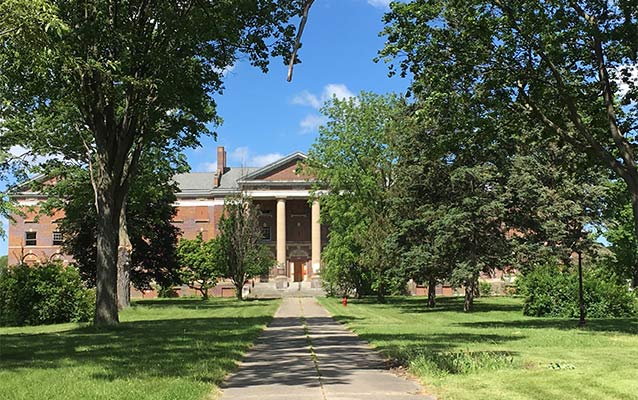Last updated: April 4, 2024
Place
Michigan School for the Blind

Photograph by Jennfer Metz, courtesy of Michigan State Historic Preservation Office
The Michigan School for the Blind Campus was listed in the National Register of Historic Places on July 26, 2018. It is located in Lansing, Michigan, west of downtown, on several parcels of land that total some forty-five acres. There are six buildings that remain from the time the school was closed in 1995. These include the early twentieth century Neoclassical Revival Main Administration (1916, 1918, and 1924) and High School (1912) buildings, the Colonial Revival superintendent’s residence (1914), and the Modern Movement library, elementary school, and gymnasium buildings (1960s). There are also two historic pump house buildings also on the site (1920s.) The campus includes a “quad” green space, various plantings, and mature trees, with concrete walkways connecting the buildings, and the decaying remains of a running track. The Administration and High School buildings are vacant and in poor condition, yet retain a great deal of historic integrity. The library, elementary school, and gymnasium retain a high degree of historic fabric and continue in use. The library houses the Neighborhood Empowerment Center, a nonprofit collective; the elementary school and gymnasium are used by the Mid-Michigan Leadership Academy, a charter elementary school. The Superintendent’s house is well-maintained, exhibits a high degree of historic integrity, and is currently vacant and for sale.
The Michigan School for the Blind represents a dedicated attempt by the State of Michigan to effectively educate the blind population in a segregated educational setting to better accommodate their need for training and instruction. The philosophy of a specific educational setting for the blind reflects the broad pattern statewide and nationally in the late nineteenth to late twentieth century prior to the change in education practices of the late twentieth century when the blind population was incorporated into mainstream educational systems. The Michigan School for the Blind campus is also significant for its early and midtwentieth century examples of school architecture in the Neoclassical Revival, Colonial Revival, and Modern Movement styles. The early twentieth century architecture reflects the popular revival style of educational institutions of that period and the design of buildings sited around a quad reflects the typical design of educational campuses popular at that time. The second major period of construction and growth of the campus is exemplified by the popular clean-lined Modern Movement school designs of the 1960s with adaptable and light-filled interiors. The Period of Significance begins with the date of construction of the oldest existing building in 1912 and ends in 1966, when the last existing structure was completed.
